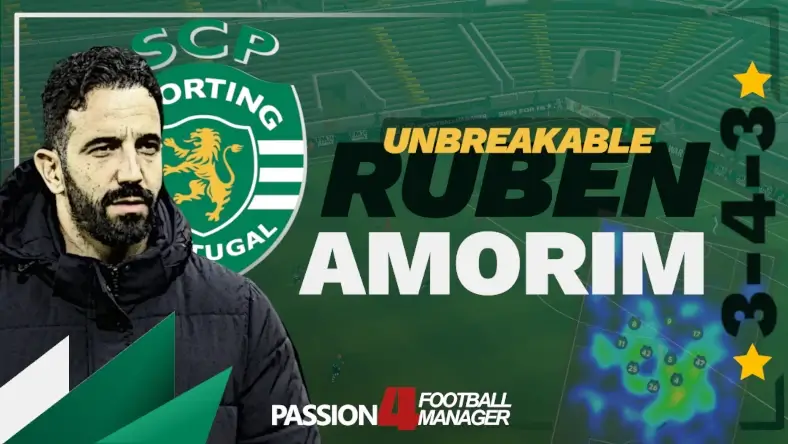Welcome to this tactical analysis of Ruben Amorim 3-4-3 Sporting tactic as we will examine the strategic approach, structures and movements that defines Sporting CP’s style of play under Ruben Amorim 2023/24 season and start of 2024/25 season, and eventually how to apply Ruben Amorim’s tactics on Football Manager 2024!
Join us for another Football Manager tactical emulation where we look at real-life tactics through a comprehensive tactical exploration before revealing how we have mimicked Ruben Amorim‘s football philosophy and tactics at Sporting CP on Football Manager.
Under Ruben Amorim leadership Sporting CP has revived the club into a Portuguese powerhouse, not only in terms of youth development but also in the Portuguese top league. In his fifth season at Sporting CP, Ruben Amorim guided the club to their 20th domestic championships in a remarkable fashion, and has written himself into the history books by breaking records at Sporting CP.
Based upon an impenetrable defence and free-flowing attacking football, Sporting CP has used rotations, creative attacking combinations and overloads in key areas of the pitch to come into goalscoring opportunities by exploiting the gaps appearing in the opposition’s shape and pull the opposition apart with third man runs, carries and speed of play that has resulted Ruben Amorim’s side to become one of the most lethal attacking sides in European football.
Table of Contents
Under Ruben Amorim’s guidance, Sporting CP accounted for 90 points in the Liga Portugal 2023/24 season and scored a record-high 96 goals(!) for the first time in the club history.
Their goals galore have really continued for 2024/25 season. At the point of writing, Sporting has accounted 4.66 goals per game, conceding only 0.66 goals per game.
Not only did they beat the previous club record of 87 points in a season, but they also achieved 28 wins and made Estádio José Alvalade into a fortress by winning all their home matches – a feat very few other teams have managed before.
His wonderful performances and record-breaking season quickly alerted the attention of English Premier League sides. Dubbed as one of the candidates to replace Jürgen Klopp at Liverpool earlier in March and rumoured to be heading to West Ham later, Ruben Amorim is certainly one of many young managers that has attracted our attention for 2023/24 season.
Now, we all know that Arne Slot eventually got the job, but Ruben Amorim’s tactics and style of play have been so fascinating to me that I quickly set about recreating Ruben Amorim’s 3-4-3 Sporting tactic on Football Manager 2024.
Today, it’s finally the time to take a closer look at the unbreakable possession-based tactics used by Ruben Amorim at Sporting CP for 2023/24 season and break down why his 3-4-3 tactics were so successful with a tactical analysis of Ruben Amorim’s Sporting tactic.
After the tactical analysis, you’ll be able to explore and download my Ruben Amorim Sporting tactic for Football Manager 2024, so you can try to replicate a similar record-breaking season as Ruben Amorim at Sporting CP on your next Football Manager save.
READ MORE | Tactical Analysis of Nagelsmann’s Germany Tactics Euro 2024
A Background on Ruben Amorim’s Manager Career
Coming through the Benfica Academy, Ruben Amorim is a former central midfielder who is deemed as one of the most promising managers in world football these days. The former Portuguese international player (14 caps) started his coaching career at Casa Pia before quickly moving to Braga’s coaching team as both B-Team manager and then first team manager for 2019/20 season.
Leading the club for only four months – between December and March 2020 – he guided the club to a memorial Taça da Liga trophy by winning 2-1 over Sporting CP and 1-0 over Porto in the finals, as well as helping the club finishing on a third place ahead of Sporting CP for 2019/20 season. This caught the attention of Sporting who splashed out €10 million to attract his services. Signing Ruben Amorim would go into the history books as the third most expensive managerial transfer to that date.
The then 35-year-old manager entered the club at a time when Sporting CP normally finished around third place. In the first season in charge, Ruben Amorim helped the club winning the Liga NOS for the first time in 19 years, and the Taça da Liga for the fourth time in the club’s history – resulting in a double for the first time since 1981/82!
In the 2020/21 season, the club nearly managed the impossible feat of going on an unbeaten run but with two matches left of the season, an away game against Benfica would be too tough – losing their first and only match for the season 4-3 in the Derby de Lisboa on 15th of May 2021.
Over the next few years and 223 matches later, the tactics of Ruben Amorim, has resulted in a 2.25 points per game achievement – winning five trophies over the last five seasons.
At the end of 2023/24 season, Sporting CP under Ruben Amorim has scored 2.8 goals per game and only conceded 0.85 goals per game – showcasing his football philosophy and tactical identity as a manager who base his tactics around a solid defensive block and a compact shape to later attack with free-flowing pass and move football. Some pundits has resembled his coaching philosophy to Jose Mourinho, and dubbed him as the Special One v2.
“His playing style is clearly pragmatic. He is a studious coach with the capacity for work and a lot of intuition. He is contagious with his will to win […] and with the conviction that only with hard work from everyone is this possible.
Paulo Meneses, head of recruitment for Braga
Ruben Amorim 3-4-3 Sporting Tactic
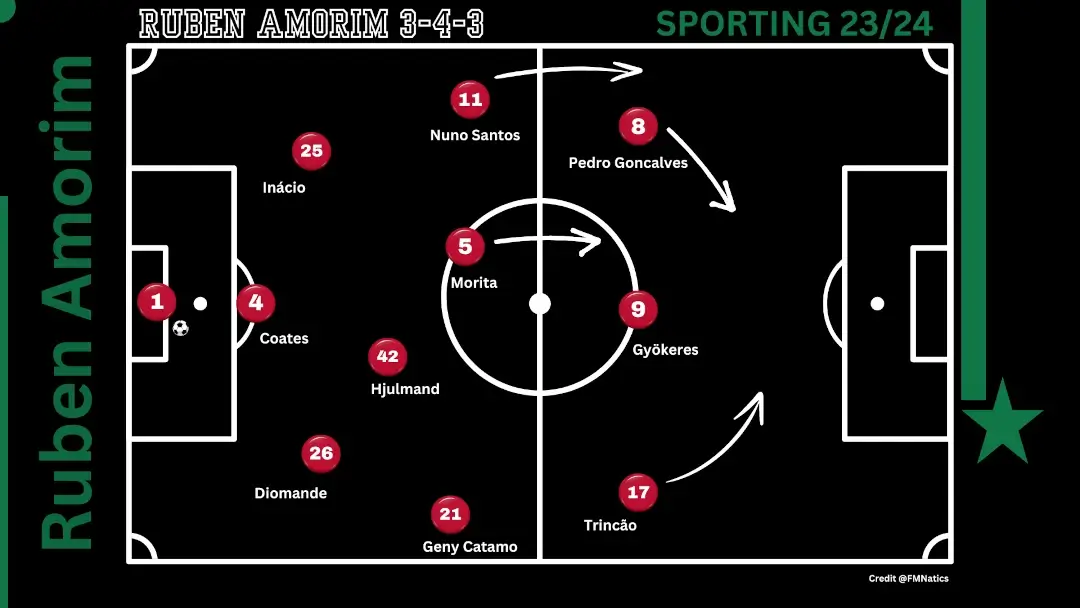
Throughout his entire coaching career, Ruben Amorim has primarily favoured to line up his teams in a 3-4-3 formation. This was also the case at Sporting CP for 2023-24 season, and the start of 2024/2025 season.
Even though his preferred framework is a 3-4-3, Ruben Amorim is a highly tactical flexible manager who is not afraid to adjust his tactical approach and playing structures to the opposition – often by alternating between a 5-2-3 wide or the 3-4-2-1AM, changing how the wingbacks and inside forwards operate according to the opposition’s structures.
Sporting’s 3-4-3 formation is based on a back three with two outer wide centre-backs who will move wide in possession and cover the half space channels to protect against counter-attacks. In front of the back three, you’ll have a double pivot who helps to protect the center of the pitch with two highly attacking wingbacks being the primary sources for providing width on either side of the two holding midfielders. Up front, Ruben Amorim favours a fluid front three with forwards who roams around to find pocket of spaces with sensational and versatile Viktor Gyökeres leading the line.
Based on defensive solidity, high press and fluid attacking movements, Ruben Amorim’s tactics at Sporting CP has been fascinating to watch!
Let us take a closer look at the tactics at Sporting CP under Ruben Amorim and how the team operates in the different phases of play by looking at how Sporting’s 3-4-3 tactics changes from in- and out of possession.
Tactical Analysis of Ruben Amorim Tactic
The Build-Up
The Back Three when Playing Out from the Back
A key component of Ruben Amorim’s possession-based tactics is his use of a back three structures where the players look to build out from the back and create a numerical superiority at the back against the opposition’s press.
In the low build-up the sweeper keeper will take an active part in the team’s quest to play out from the back. This creates a 4+2 structure where the ball-playing goalkeeper position himself on the same line as one of the centre backs.
When the goalkeeper is in possession, the two outer centre-backs will split wide playing almost like fullbacks, meanwhile the wingbacks will stay high and wide.
The double pivot will drop deep to maintain numerical superiority at the back whilst also aiming to beat the opposition team’s high press.
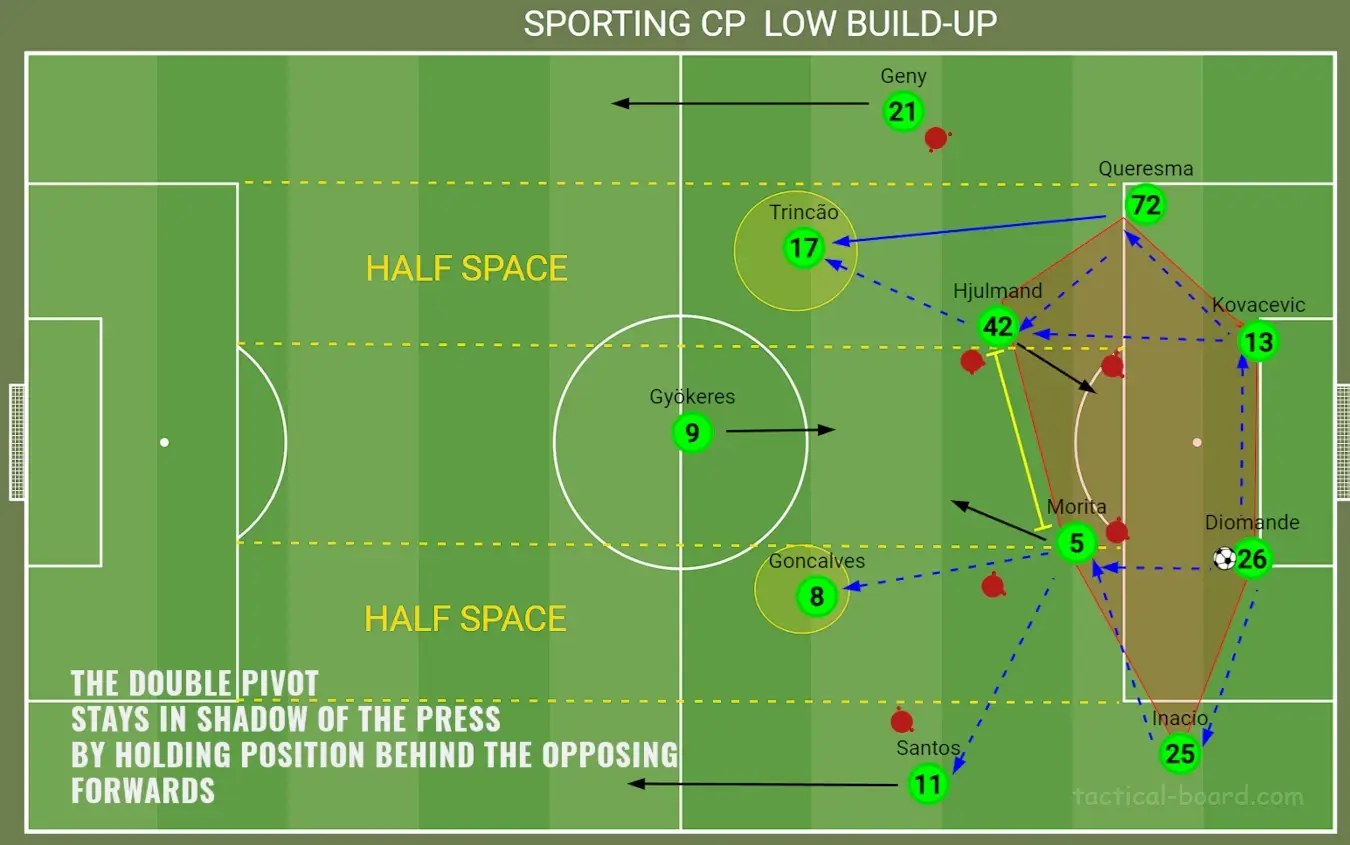
The centre backs will take up a position in each of the half space channels, while the left outer centre back will hold position inside the wide channel in zone 1 or 4.
The positioning of DCL and DCR aims to provide the necessary angles to progress play towards the flank but when they receive the ball, they can also initiate progressive passes between the lines towards the double pivot who can turn and look for either the wingbacks or the Inside Forwards who finds pockets of spaces in each of the half space channels near the halfway line.
The role of the wide centre-backs is important when building out from the back. Not only will their wide positioning stretch the opposition’s first line of defence but it will also create space and passing lanes to move the ball inside.
Then, depending on the player and the opposition’s defensive shape, Ruben Amorim is no stranger to ask his central defender to move into the midfield in the low build up.
This enables the team to build out from the back with a 2-3-2-3 structure at goal kicks.
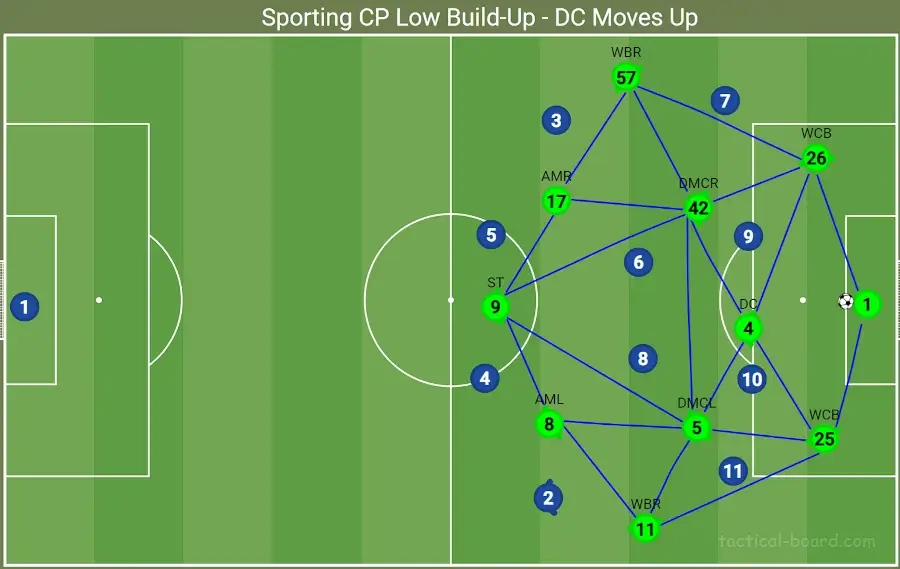
When the central defender moves up, it creates a numerical advantage that helps to beat the high press and provides a minimum of three passing alternatives for every player in the build-up phase. This lures the opposition to defend in the middle and free’s up the space for the wingbacks to receive.
It will mimic the advantages teams using the 4-3-3 has at low build-up when coming up against the traditional 4-4-2 system – trying to outnumber the opposition’s first line of defence with a structure that provides better circumstances to retain possession and build their way out from the back.
In fact, you’ll get a 3vs2 advantage in the middle and the extra man staying on the edge of the penalty box provides several dilemmas for the opposition. To limit the advantage in the middle, the opposition will force to commit the wingers to stay narrow if they are playing with a lone striker – leaving space down the flank for the wingbacks to receive the ball.
Or, if they are using a 4-2-3-1 system, the attacking midfielder will have to move press higher up, leaving an extra man in the middle of the pitch with central defender pushing up in the space between the double pivot.
Another interesting tactical aspect with Sporting CP in deep build-up situations is how much space there is between the double pivot and the attacking midfielders.
This is all part of Ruben Amorim’s plan!
By dropping seven players down in the low build-up, the front three will provide counter-attacking opportunities which the opposition has to consider.
Pushing too many men forward to press high enables the defenders to look to exploit the space between the defensive and midfield line of the opposition and look to play more direct passes towards the front three who has the speed of movement, one-on-one abilities and ball control to move the ball into the final third.
With the positioning of the double pivot who stays in behind the press, the front three can use bounce passes and back passes to free themselves from their marker, if they have someone breathing them down the neck.
This pass and move strategy are something we see in every attacking situation. Ruben Amorim uses these forward-knock-it-back-forward passes , and third man runs from deep, to take advantages of the difficulty for the opposition to cover all the players, their runs and the vulnerable zones on the pitch.
READ MORE | Football Manager 2024 Pep Guardiola’s Barcelona Tiki-Taka Tactics
In fact, as Football Meta says, you end up in a situation where you don’t know who will come to a goalscoring chance as it could be anyone within the front five – or six – depending on the late runs from one of the players within the double pivot.
How Amorim Replicates de Zerbi’s Build-Up Principles at Sporting
When the players are in possession of the ball in the build-up, Ruben Amorim ask his defenders to follow many of the same principles as Roberto de Zerbi used at Brighton & Hove Albion.
Apart from the 4+2 structure at deep build-up and the aim to create numerical superiority to beat the high press, Amorim’s Sporting and de Zerbi’s Brighton behaves very similar when building out from the back.
Like de Zerbi, Amorim asks his goalkeeper or his central defenders to take an extra touch on the ball, perhaps even stop the ball from moving by putting their spikes on the ball. This aims to bait the opposition into pressing them by evoking a reaction to move out of their defensive shape.
Then, you might see square passes between the goalkeeper and the centre backs, or the centre backs and the defensive midfielders, all done to try to trigger a press from the opposing forwards.
If one of the opposition players in the first line of defence tries to close the player down, it creates a hole behind him that could be taken advantage of. When the opposing forward triggers press, it creates a free player deeper on the pitch who can move into pocket of spaces.
The player in possession of the ball can then look for third man combinations and try to make a through ball between the lines once the forward initiate a press, as his movement will open up passing lanes, or create open spaces to receive the ball in another part of the field.
The use of shorter passes in a rather slow tempo at the back is all part of the plan to free up players and passing opportunities erupting between the lines. The aim is to make the opposition impatient in their defensive block as they seek to win back possession by rushing out of their defensive positioning.
At Sporting CP, it’s a clear plan to use the double pivot as clear alternatives to progress play. Holding position behind the opponent’s high pressure, they can easily use bounce passes as a strategy to beat the press. With two passes, from the centre backs to the defensive midfielder and back again, the midfielder can become free of marking to receive the ball.
Once the pass is made, the players in the shadow of the press can make subtle movements that opens new passing lanes and alternatives for the ball receiver – perhaps even creating the necessary space to make secondary line passes towards the front five.
When the defensive midfielder receives it in the shadow of the press, he can either turn with the ball, use his body angle to progress play towards the flank, for instance to find the wingbacks or the attacking midfielders further up.
If one of the outer centre-backs receive the ball from the defensive midfielders, the player can look for through balls and opportunities to progress play into the middle or final third by making counter-attacking passes behind the opponent’s defensive line – especially effective if the opponent defends with a high defensive line, or play the ball between the lines to a player who is free of marking higher up the pitch. This player has often used subtle movements to position himself in pocket of spaces.
Frankly, we can summarize Ruben Amorim’s tactical plan as:
- Attract the attention of the players within the first line of defence
- Use square passes to create a free player behind the press
- Look for the third man
- Find the wide player
- Encourage third man runs on the opposite side of ball location
- Look for those late runs from deep
The Double Pivot
Ruben Amorim’s Sporting tactics is based upon a double pivot with Morten Hjulmand and Hidemasa Morita next to each other. However, it’s rarely the first and second pivot is positioned on the same line – unless it’s in the defensive shape.
The double pivot’s main job is to provide balance in the middle and free’s up the defensive responsibilities of the attacking wingbacks. With a 3-2 rest defence with the double pivot in front of the back three, the wingbacks can move higher up the pitch, help to maintain width and stretch the oppositions back line to create spaces for the Inside Forwards to move into the channels.
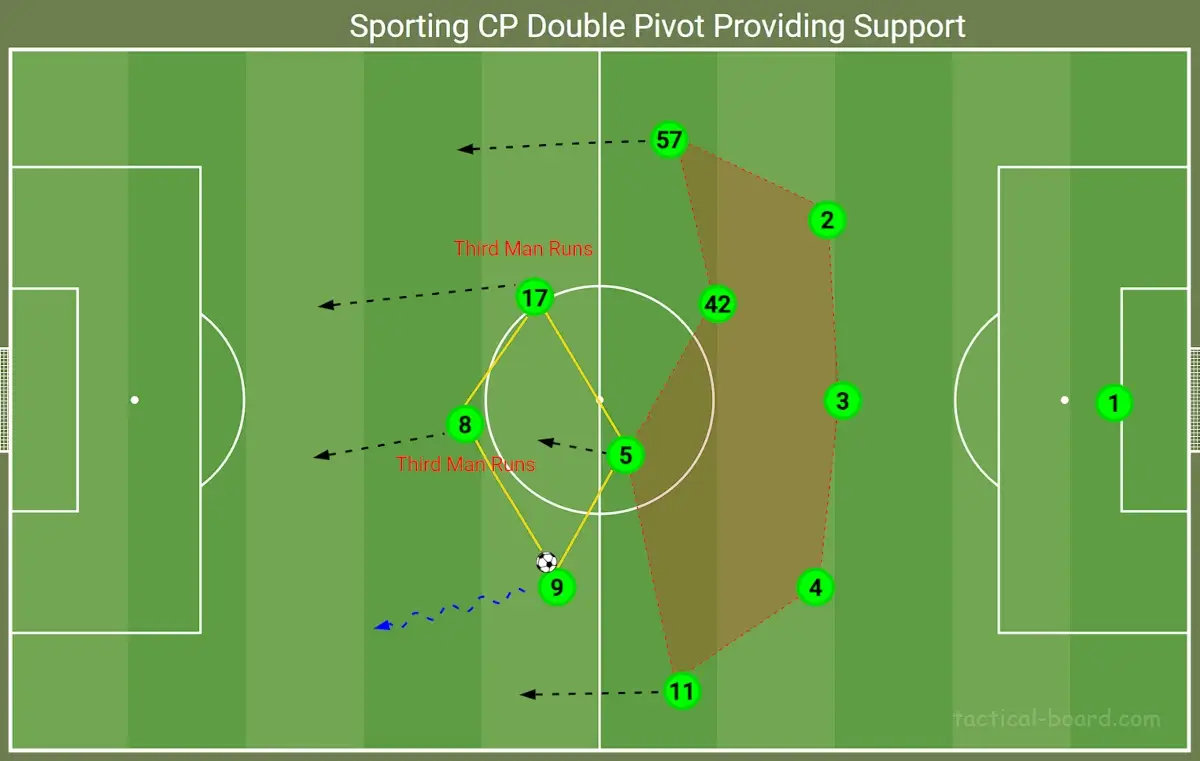
In possession, the defensive midfielders will alternate their positions depending on where the ball is, and each other’s movement. When one defends, the other will support the front three with surgical precision late deep forward runs and those third man runs through the middle that free up space for the forwards to receive the ball in between the channels.
Normally it’s Morita who holds position close to the centre backs and protects the defensive line from counterattacks with the second pivot free to make more penetrating forward runs from deep positions.
Against Nacional earlier in August 2024, Daniel Braganca was favoured to overload the opposition’s defensive line and move in support of the front three by making more third man runs into the penalty box as play moves into the final third.
But who will defend and who will support the forwards will depend on where the ball is and what is favoured between retaining possession or overload the opposition’s defensive line.
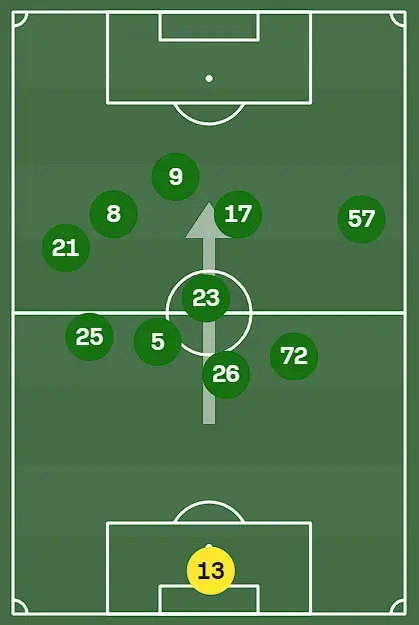
Often positioned themselves in an angle to each other, their positioning can both help the team to beat the press as well as open up more passing combinations for the rest of the team.
The two holding midfielders is not only important in the matter of creating numerical superiority around the ball zone. Their angled positioning will also aid the team in the attacking transition. Holding positioning in the middle of the pitch, they work tirelessly to become the free player.
This image of the average positioning of Sporting CP versus Nacional provides you with a great illustration of how the double pivot is positioned according to each other with one staying more centrally and the other playing slightly wider at the edge between central and half space channel.
How Ruben Amorim uses a box midfield within the 3-4-3 Sporting tactics
The use of a double pivot infront of the back three together with two Inside Forwards to pick up positions in the half space channels creates a box midfield structure.
Amorim’s 3-4-3 formation can be described as two units of five, or a 7 + 3 when the wingbacks drop deeper. You have the defensive unit sitting in a 3+2 structure if we don’t consider the goalkeeper who takes part of the build-up, meanwhile there is a 4+1 structure staying higher up the pitch – which can resemble a box midfield once the Inside Forwards moves into the half space channels.
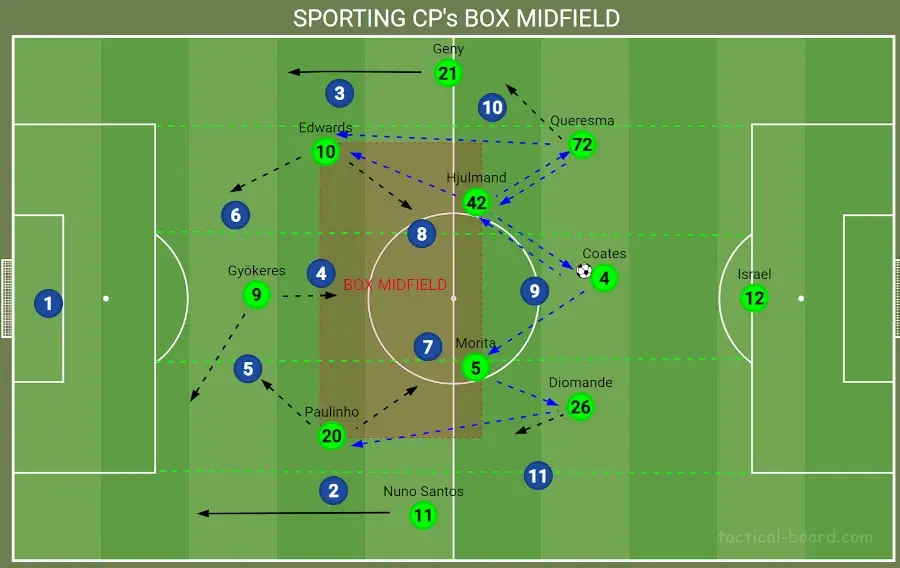
As the outer centre-backs move wider and closer to the wingbacks, the Inside Forwards will hold positioning in each of the half spaces channels. By staying high but narrow, the opposition must consider counter-attacking opportunities and must defend rather deep with their defensive unit.
However, once the ball goes to the flank, the attacking midfielders will drop through the inside channels and move into the vacant space in the middle of the pitch.
In these circumstances we’ll have a box midfield where we have a 3-4-2-1 shape. Which players or positions you got in the back three will depend on the rotations. The box midfield will provide a numerical superiority once the ball is progressed towards the middle of the pitch – which is what Ruben Amorim desires.
The distance of the forwards and the positioning of the double pivot aims to stretch the opposition and provides a great foundation for both counter-attacking initiatives, as well as being able to regain possession in the middle of the pitch if possession is lost.
Defensive Shape
Out of possession, Sporting CP prefers to defend in a 5-2-3, a 5-3-2, or a 5-4-1 where one or both of the ‘Inside Forwards’ drop slightly deeper to congest space in the middle. This forces the opposition to attack down the flanks, rather than through the centre of the pitch.
When the wingbacks drop into the defensive line, Sporting CP protects each of the five channels with a rather compact defensive shape with few metres between the lines.
With few metres between the lines and by congesting the middle when out of possession, Sporting CP is hard to break down.
Out of possession, Ruben Amorim favours to use a 5-2-3 structure in a mid-high defensive block aimed at protecting the middle.
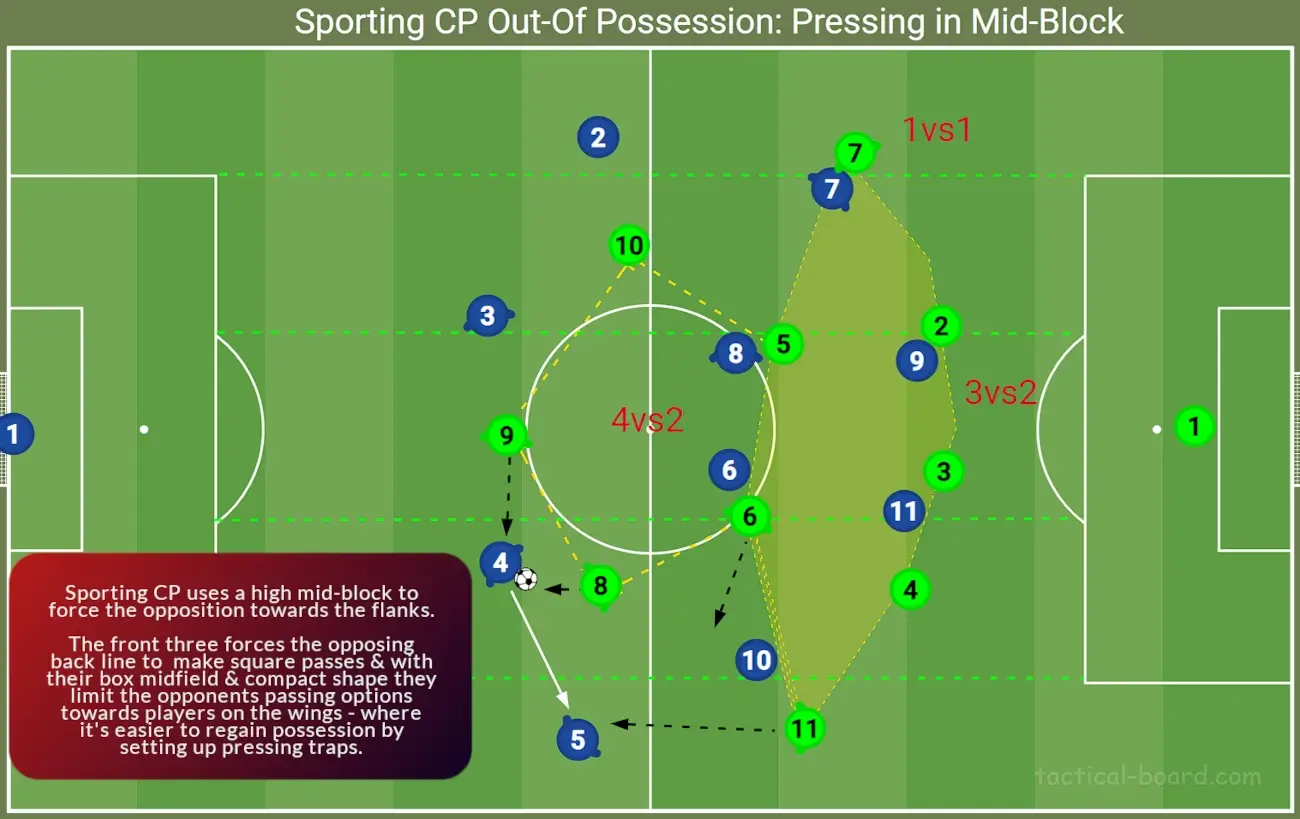
Their defensive shape often forces the opposition to attack down the flanks as it would require players with excellent flair, work rate and off the ball movement to pull Sporting’s defence apart, or it would require players of amazing technique, ball control and vision to make quick short passes and passing combinations to play through the middle.
When defending, Sporting CP often favoured to push their defensive line higher up the pitch and congest the space in the middle. One of the wingbacks would push up and tight mark and trigger press towards the opposing wide player, while the wingback on the opposite side of the ball location would drop into the defensive line – maintaining a back four.
When defending, the aggression, positioning and work rate of the double pivot was key to their ability to protect the middle.
Always trying to close down and limit the time the opposing player has the time to pick out a pass or use his tactical intelligence to force either longer passes towards the opposite flank, or force a pass that the other defensive midfielder, or one of the wide centre-backs, can intercept if they push out of their defensive line, or makes a covering run, their mobility to cover larger distances and squeeze play enabled Sporting to regain possession, or limit the opposition to make square passes.
In these situations, Sporting tried to force the opposition to make passes towards the width or unfavourable passes that is aimed backwards or sideways. This enabled the team to push their defensive block slightly higher up the pitch.
The Inside Forwards would have an important role in these circumstances. Their positioning in the mid-block ensures a 4vs2 advantage if coming up a traditional 4-4-2 formation as they easily become very compact in the middle when the Inside Forwards move centrally and the double pivot covering the space behind their press.
The illustration above, reveals how back press and staggering of positioning can create numerical superiority around the ball zone as the players forms triangles and squares that enables them to limit the opposing player from having multiple passing options further forward.
Attacking Third
A strong defence provides the backbone to Sporting’s offensive play. In fact, it’s in the attacking phase the magic happens!
Sporting is a remarkable team in attacking situations. Over the last few years, Ruben Amorim’s Sporting side has evolved from making 14.1 shots per game to 16.5 shots per game and is a side who creates lots of chances and score most of the goals from open play.
From defending in a 5-3-2 structure, Ruben Amorim favours to attack in a 3-2-5 shape which can also become a 3-1-6 shape at times. It all depends on the movement of one of players within the double pivot, and how far up he moves.
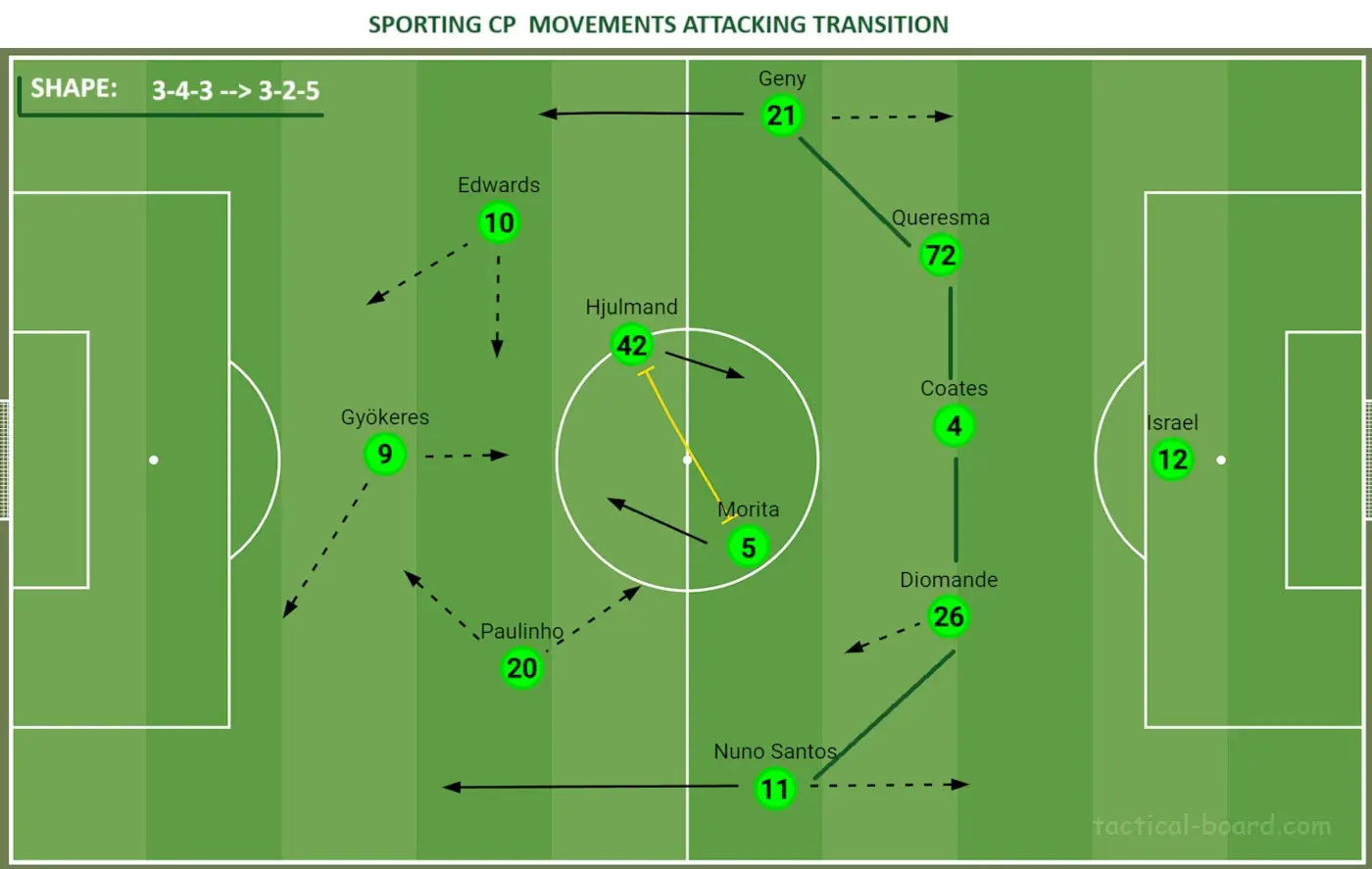
Normally, when Sporting is attacking, the second pivot would move into the space behind the target forward and get further forward just like a Segundo Volante. His forward runs in attack created a diamond structure with the Inside Forwards to his left and right.
Here’s an illustration of how Morita operates in the attacking transition and creates a 3-3-1-3 structure before the shape becomes a ‘unbelievable’ 3-1-6 structure in the final third.
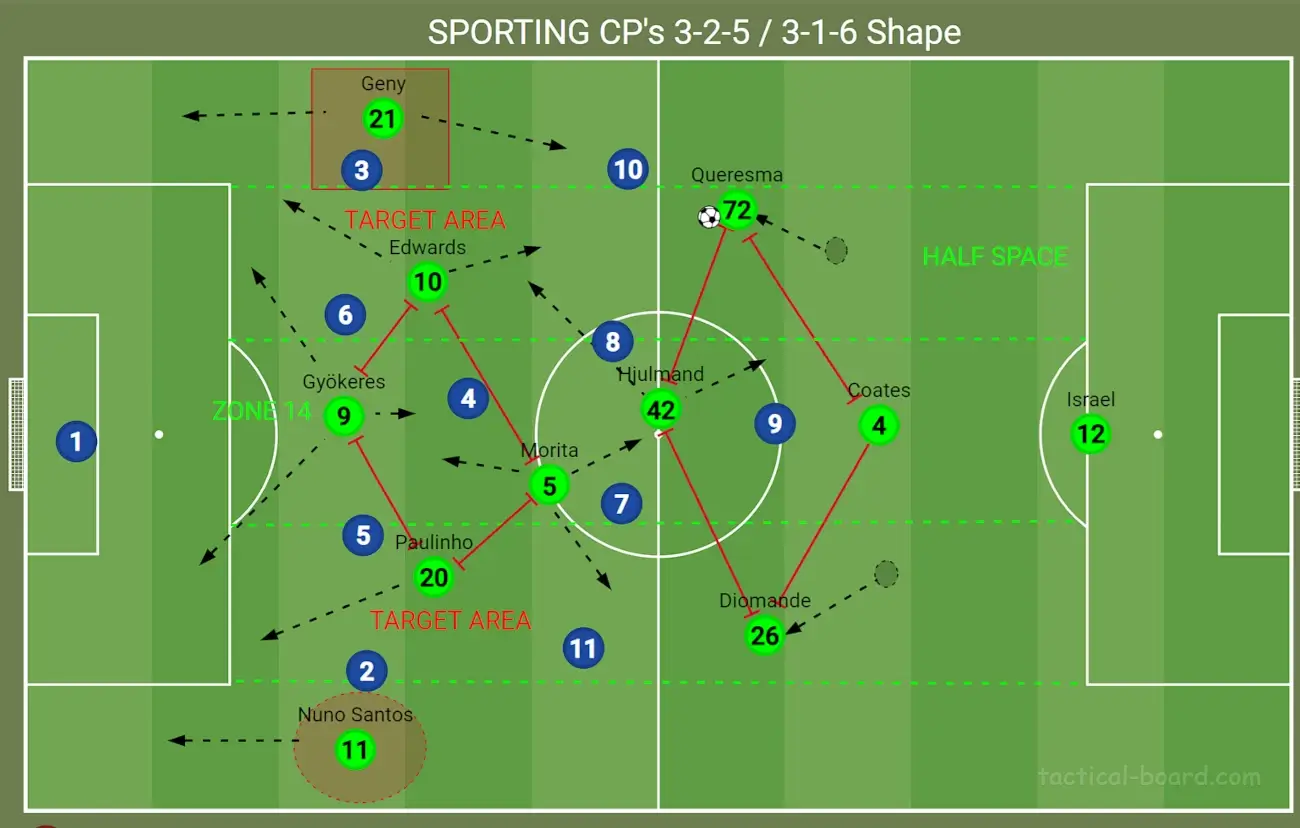
Led by the trio Viktor Gyökeres, Pedro Goncalves and Francisco Trincão, Ruben Amorim is fortunate to have a fluid front three who can both create goalscoring opportunities on their own or pull the opposition apart with opposite runs and movements that creates space for each other. Their attacking instinct and sublime decision-making on when to pass, shoot or run, or which areas of the pitch to penetrate in provides you the ultimate attack.
Always ready to find pocket of spaces, tends to move into the channels and then make opposite runs of each other, the Inside Forwards roams around the pitch and aren’t necessarily just maintaining position on the left or right flank.
Often, we see one of the Inside Forwards moving centrally whilst the target forward pushes either forward or to the opposite side of the ball zone.
These forward runs by Gyökeres aims to provide depth for the Inside Forwards behind him to combine and overload the retreating defender as the target forward drags at least one of the defenders with him with his runs towards the space in behind the opposition’s defensive line.
As the average positions reveals, it’s often the right Inside Forward who moves more centrally whilst the left Inside Forward targets the left half space. If we should translate the positioning of the right Inside Forward into Football Manager, we could easily set him up as an Attacking Midfielder in the AMRC position.
The positioning of the Inside Forward working the inside left channel results in an overload on the left flank as he builds a partnership with the left attacking wingback.
On the right, you’ll have a typical underload as Ruben Amorim instructs the right Inside Forward to move more centrally – enabling the right wingback to be the only one to provide width.
At least, this is especially the case when the ball is on the far side of AMR and WBR.
Focus of play
This overload on the left can be seen in the attacking focus chart. Ruben Amorim’s Sporting tactics often prioritize to focus play down the left flank due to their reliance at setting up overloads on the left flank.
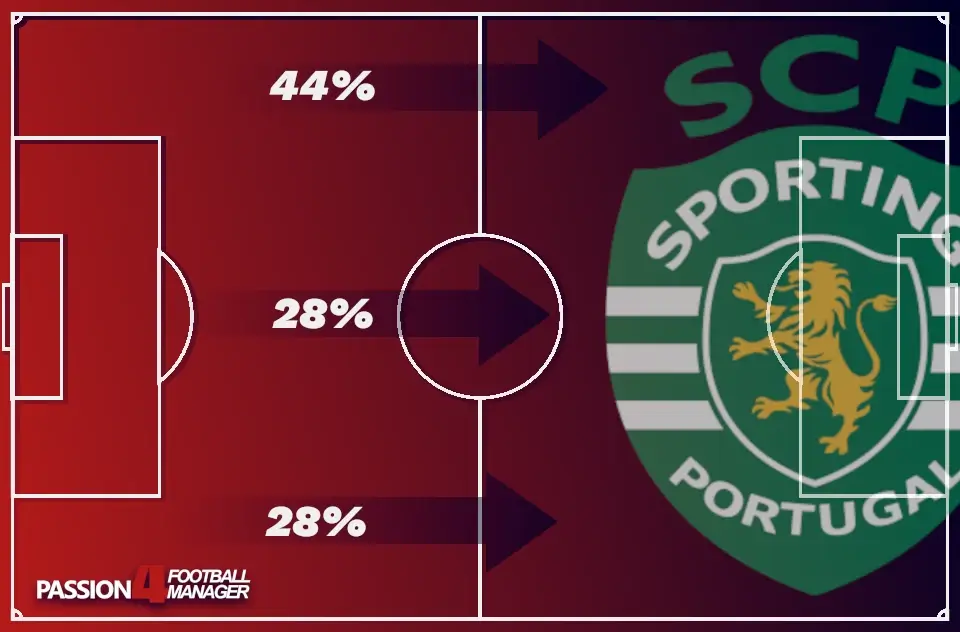
Entering The Final Third From Wing Play
At Sporting, Ruben Amorim has converted technical-gifted wingers into attacking wingbacks. The importance of Nuno Santos in Ruben Amorim’s tactics can’t be underestimated.
By asking the wingback to overlap, stay high and attack towards the byline, it creates an overload down the left flank which can create space in the centre or on the opposite flank.
As a player who can hold up the ball regardless of pressure, who can come out of one-on-one situations successfully and drive to the byline to get crosses or cut-backs into the box, Nuno Santos provides another dimension to Sporting’s attack, apart from just trying to get the ball into the inside channels.
By providing width in the final third, Nuno Santos can be an outlet if the team needs to switch the play. His wonderful 1v1 abilities and attacking skills helps Sporting to both isolate the opposing fullback. Together with the left Inside Forward, they help to create chances from the left wing by overloading the flanks.
The presence of the two attacking wingbacks is essential once play enters the final third.
What’s apparent is how the wingbacks execute their roles slightly different to each other. Nuno Santos is highly attacking with a higher presence in the final third.
He delivers more crosses, key passes, makes more touches in the attacking third, and overall makes more progressive passes and carries – acting like an attacking complete wingback, while the player on the opposite side will provide more balance to the team and focus more about providing width and cover – recording less touches on the ball, slightly fewer key passes and crossing attempts.
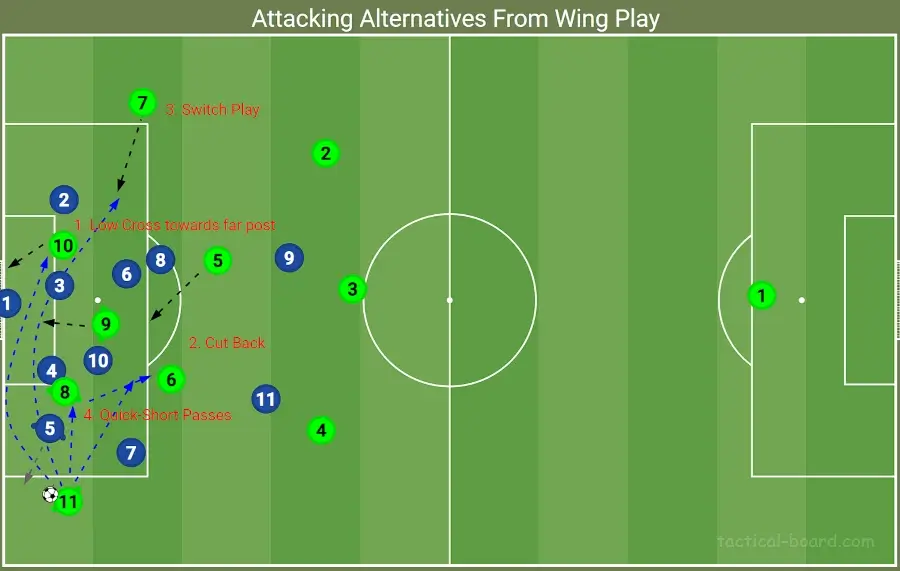
Instead, he often makes more dribbles and looks to cut inside or create the necessary space for the Inside Forward to move between the opposite centre-back and fullback looking for underlapping runs down the right side.
However, when the right wingback is in possession of the ball, he can easily cross the ball towards the back post, or switch play to the opposite side to tilt the opposition defensive block.
Attacking Transition
One of the trademarks of Sporting CP’s tactics is the use of quick counter-attacks to move the ball into the final third. Rather than playing a patient short passing possession-based football, Ruben Amorim instructs his players to look for potential breaks as soon as the opportunity arises.
Rather than always playing short passes at a low tempo, the wide centre-backs tend to look for progressive passes launched towards the narrow Inside Forwards, or the Complete Forward, who can either carry the ball towards the byline, combine with his wingback to create those 2vs1 situations on the flanks by looking for overlaps from the wingbacks, or look to play through balls to the complete forward, who tends to shift his movements patterns between making runs away from the ball zone, or come deep to link up play.
Time and time again, we see Sporting CP skip the build-up in the middle third of the pitch to launch diagonal passes in between the lines to one of the players in the front trio.
Based on a rest attack of three forwards who are always ready to carry the ball into the final third, Sporting’s back five looks towards the forwards with progressive passes to catch the opposition when they are the most vulnerable – after loosing the ball and is transitioning from in possession of the ball to the defensive transition.
There are three positions interesting in the aspect of Sporting’s attacking transition:
- The role of the double pivot in the attacking transition
- The wide centre backs positioning and passing tendency
- The wingbacks creating space for their teammates
So far this season, Morita has made 1.3 key passes per game, meanwhile he made 0.9 key passes per game last season. Hjulmand however, made 0.7 key passes per game last season with 4.20 progressive passes compared to Morita’s 6.42 progressive passes per game.
However, the importance of the two outer wide centre-backs in the back three within the attacking transition phase can’t be underestimated.
Last season, Goncalo Inacio made 8.68 progressive passes per game whilst Eduardo Quaresma made 5.15 progressive passes per game – describing how essential the wide centre-backs were at Sporting CP to progress play in the attacking transition.
Often, Sporting looked to their wide centre-backs to progress play into the final third.
While the wingbacks would hug the touchline and stretch the opposition by staying very wide meanwhile the Inside Forwards would find pocket of spaces inside the half space channels – staying rather narrow and in support of Gyökeres, the wide-centre backs in possession provided the ideal circumstances for Sporting CP to look for counter-attacking moves behind the opposition’s high defensive line.
Time and time again, Sporting looked to skip the entire build up in the middle third and change the tempo of play from short and low tempo to a quick more free-flowing attacking football where the front trio plus the wingbacks looked to move directly towards the opposition.
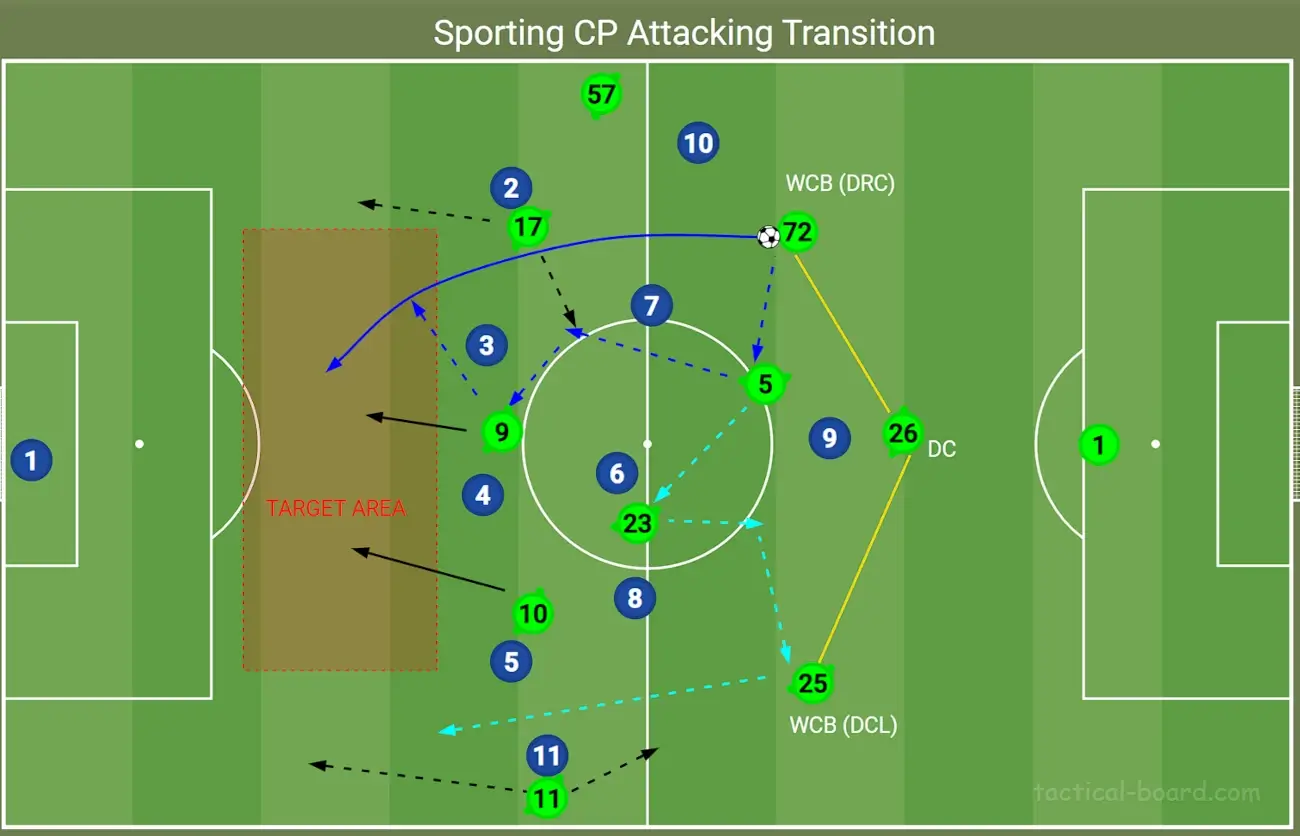
Often, the wide centre-backs would look to play longer pin-pointed passes to the forwards and thereby quickly reach the final third with one ball played between the lines.
Then, it was up to the quickness, ball control and attacking movements of the front trio to run with the ball into the attacking third and combine with each other.
When in possession of the ball, Ruben Amorim’s tactical plan takes advantages of many of the same principles as Pep Guardiola.
You’ll see third man runs, one-two’s and a focus on setting up players for goalscoring opportunities by looking for runs in the half space channels.
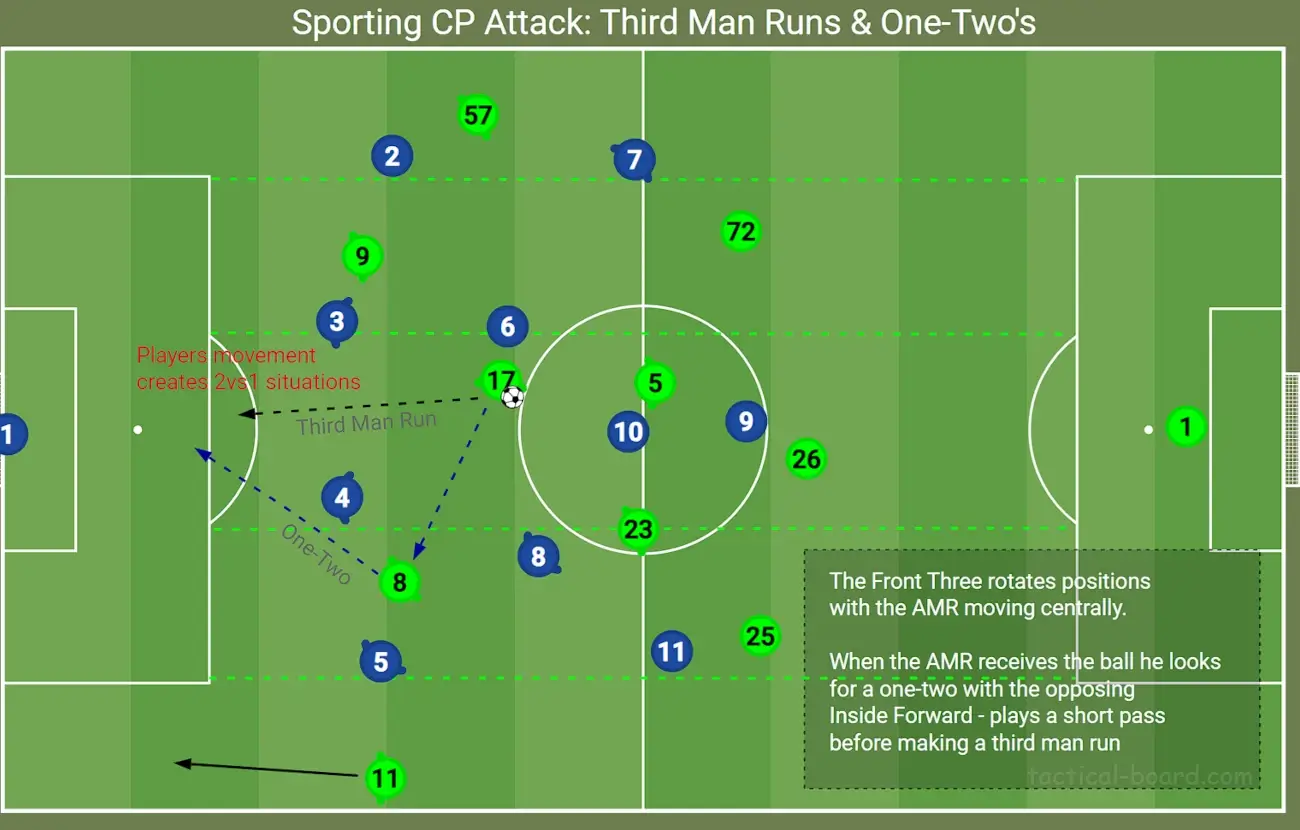
This is a great illustration taken from the match against Nacional showcasing how the front trio operates and how they combine with quick short passes between themselves before being on the finishing end of the pass.
In these circumstances, it’s often the player who made the pass to the one carrying the ball towards the goal that becomes on the finishing end of the chance. If you pay attention, you’ll discover how one or two of the forwards first sprints forward to force the opposition to get back before he slightly delays his run and picks up position in the vacant space in front of the back line.
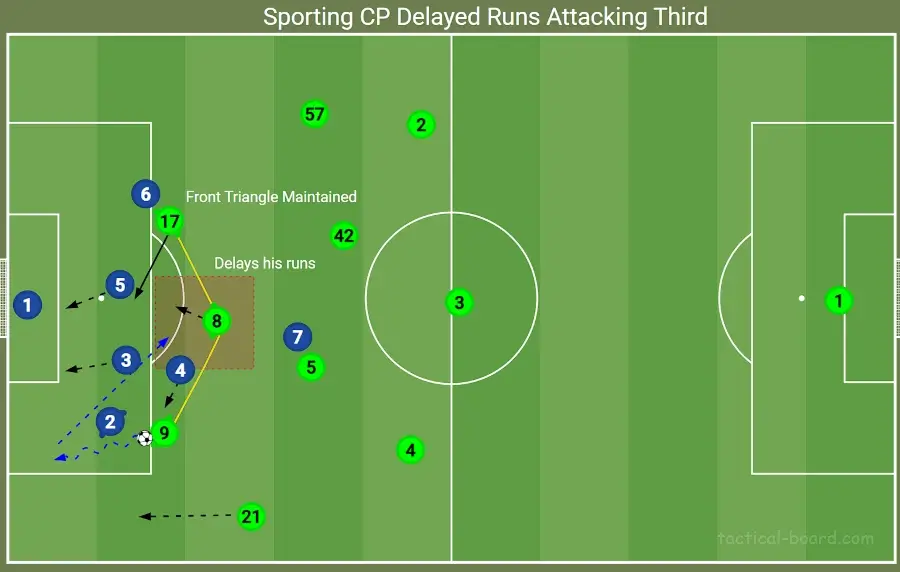
Creating Overloads in Half Space Channels
In the attacking phase, Ruben Amorim’s tactical plan is aimed at creating overloads in the half space channels. With a front trio who moves fluidly around the pitch to find pocket of spaces to receive and penetrate in, Sporting’s attack is based upon rotations that aims to create the free man between the lines.
With surgical precision runs and through balls, the front three can be used as outlets in the attacking transition. As the defensive unit of five players look for through balls towards Gyökeres or one of the Inside Forwards who have dropped into the channels, the fluid front three can easily turn with the ball and set up his partner for a chance on goal as they carry the ball towards the penalty box or make well-timed through balls delivered into the vacant space behind the opponents back line.
Read more | Viktor Gyökeres position & style of play by the Coaches Voice
All the time, the forwards are positioned in a triangle – helping each player to have at least two passing options nearby with more deeper alternatives erupting with the late forward runs from one of the holding midfielders, or the wingbacks providing support on the wings.
The use of opposite movements between the forward trio and the attacking midfielders and the wingbacks causes decision-making problems for the opposite defender.
While one player moves into the channels, or gets forward, another will drop or move towards the center to open new passing lanes.
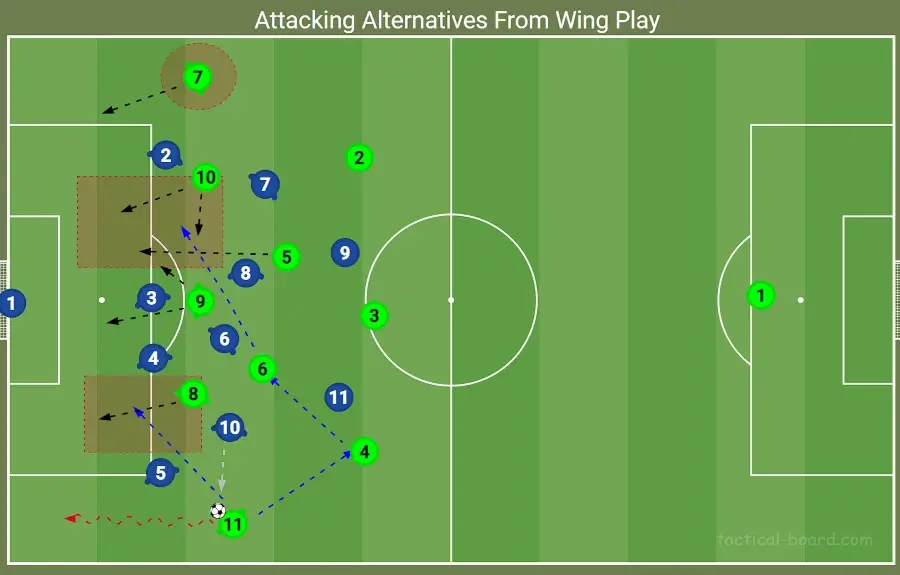
What’s evident, is that Sporting’s attack is based upon players who initiates moves into different zones at every opportunity. Sometimes two of the front-three will move into the same zone (e.g. the right half space channel) to overload the opponent’s defence, while the third attacker moves into a more central position on the same side of where the ball is located.
At the same time, the wingback will provide opportunities to switch play to the opposite side of the pitch with their wider positioning.
Settled Attacks
In settled attacks, Sporting tended to use either cut-backs or low crosses towards the penalty area. In these situations, the physic of Gyökeres and sublime aerial abilities or finishing technique, or the ability of the Inside Forward (Geny Catamo, Trincão or Quenda) to find pocket of spaces by making late runs towards the penalty spot were two ways Sporting scored goals from working the ball down the left wing.
In attacking situations, Sporting CP was no stranger to push many men inside the penalty box and overload the opposition with 5 to 6 players inside the penalty area in settled attacks. This pushes the opposition deep into their own half which frees up space in front of the backline for cut backs from the wingers towards the defensive midfielders who have taken up positions on the edge of the penalty box. If they receive it, they can become a goalscoring threat from distance by either making long shots or quick combination passes with the Forwards who finds pocket of spaces as the opposition push out of their deep low block.
[image settled attacks – long shot opportunity from dm]
In these attacking situations, you will often see one holding midfielder + the back three protecting the centre of the pitch and squeeze play by holding a very high defensive line.
This will be essential in the plan to counter-press the opposition and help to dominate the opposition on their own half with their possession-based football.
By instructing the players within the double pivot to hold position in the middle of opponent’s half, and the back three to push up, you will have a rest defence of 3+2 with few metres between the lines.
If the attack comes to nothing and the opposition manages to recover the ball, the shortened distance between the front five and the rest defence can eliminate potential counter-attacking moves by picking up second-balls and cut backs.
Pressing
In Liga Portugal, there are few other teams that stands out for their remarkable pressing stats. With their intense pressing, often high up the pitch, Amorim’s Sporting side looks to regain possession as quickly as possible.
With their 3-4-3 tactics featuring 8 players covering the centre and the two inside channels, Amorim wishes to protect the centre of the pitch and looks to set up pressing traps down the flanks.
The body angle and positioning of the front five creates the perfect trapezoid to quickly regain possession if one of the opposing midfielders has a heavy touch. At the same time, their positioning reduces the passing options and sets the opponents central attackers in a passing shadow of their central midfielder.
When the opposition is building out from the back, Ruben Amorim’s Sporting instructs his players to prevent short goalkeeper distribution by asking his two Inside Forwards to hold position at the edge of the penalty box whilst the forward drops deep and tight mark the opposing holding midfielder.
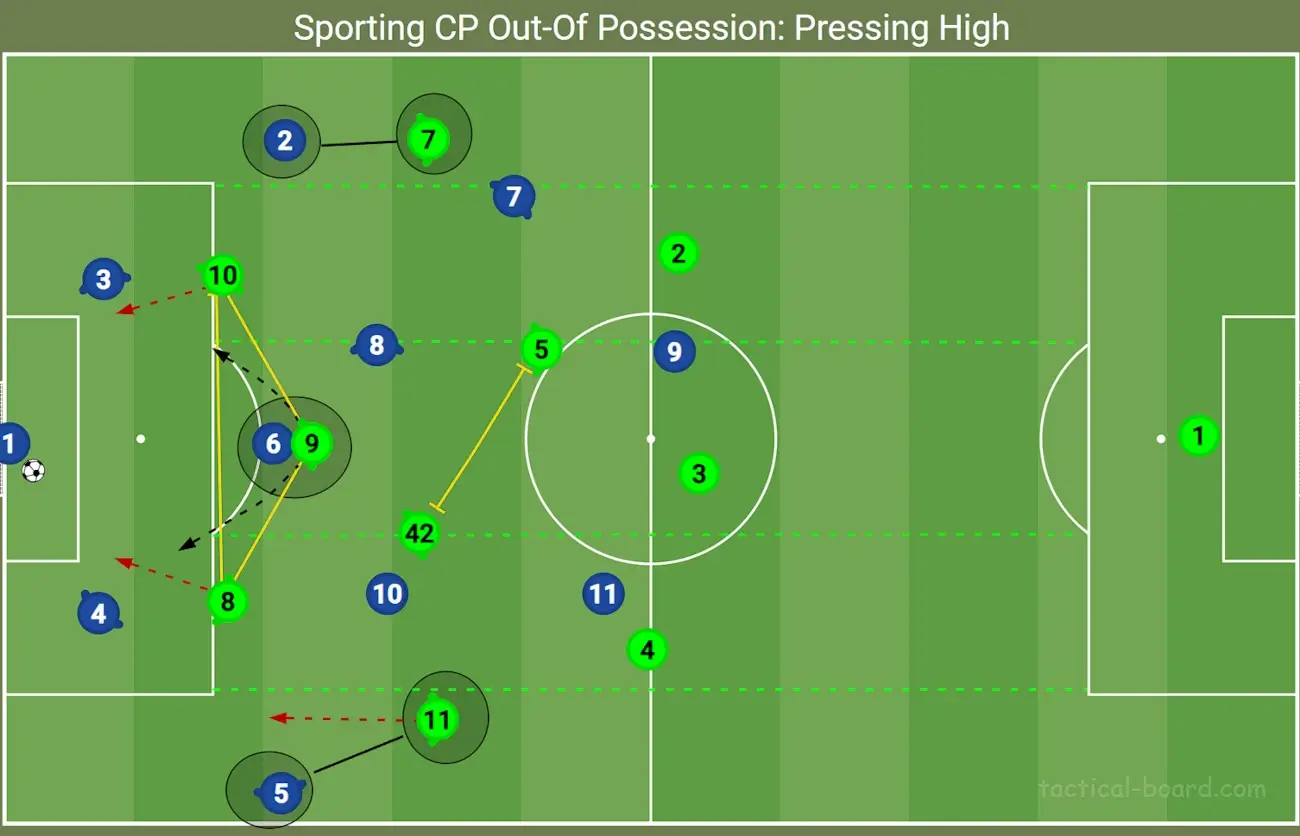
Their 2-1-3 high pressing structure is set up with a rather narrow and compact shape where the front three limit the opposition to play towards the flanks rather than through the middle.
Viktor Gyökeres is a wonderful player to have when pressing high. His aggression, positional awareness, physic and quickness enables him to be the ‘perfect Pressing Forward’.
When pressing high, Sporting uses to push the opposition to one side with one of the players within the double pivot being in close distance to trigger press on the opposing central midfielder. He will be essential once the time is ready to set up the pressing trap as he moves wide to create that 3vs2 numerical superiority around the ball zone once the opposing fullback or winger is in possession of the ball.
How the second pivot operates out of possession in high pressing situations depends slightly on the opposing formation. At times, he will move slightly further forward, be staying in close proximity to the forward as he tight marks the opposing midfielder – for instance if playing with a double pivot and the opposition builds out deep with a 4+2 structure.
At the same time, the wingbacks will push slightly further forward providing the security down the flanks to quickly close down or intercept any passes towards the opposing fullback, and thereby regaining possession far quicker than if they stayed within the team’s backline.
With the aggressiveness of the front three to limit the opposition’s passing options and press high at deep build-ups, Sporting CP has managed to quickly regain possession high up the pitch which has eventually resulted in a goal due to their quick counterattacks or by forcing the goalkeeper to make inaccurate passes that can be intercepted and then score from a well-placed shot.
Wide Pressing Traps
As one of the key strategies for Sporting CP to win possession, the team likes to set up wide pressing traps. The 3-4-3 formation is the ideal shape to use to press the opposition down the flanks.
To make it work, you’ll need Inside Forwards who can work tirelessly to limit space and close down the opposing fullbacks. To make these wide pressing traps successful, they need to move wide with the double pivot moving across the pitch, from side to side, to tight mark and aggressively press the opposing midfielders to limit the number of passing options towards the middle of the pitch when the opposing fullback, or winger, is in possession of the ball.

In these situations, the pressing structure of Sporting creates a 3vs2 or 2vs1 numerical advantage when the wingback, defensive midfielder and the Inside Forward work together to limit the space and time for the opposing player.
This means that the wide Forwards can’t stay too narrow out of possession, otherwise the opposition can easily beat the press with quick combinations. This means that a 3-4-2-1AM requires attacking midfielders with high work rate, aggression and if we should translate this to Football Manager, setting up specific opposition instructions to force these players to trigger press out wide.
The brilliance is that the Inside Forward presses the player on the ball from behind. Helped by the byline, it locks the player in a tight area down the wing that may be difficult to come out of with the ball.
In the 6-1 trashing of Nacional in GW2 of 2024/25 season, we could see how Sporting effectively won possession by dispossessing the opposition winger and use short combinations to set up Pedro Goncalves in a situation where he could carry the ball towards the penalty area and place the ball at the back of the net.
Amorim’s use of wide pressing traps is a great strategy to use in Football Manager too, especially when coming up against wide formations, such as the 3-5-2.
Football Manager 2024 Ruben Amorim 3-4-3 Sporting Tactic
Through our tactical analysis of Ruben Amorim’s 3-4-3 tactics at Sporting, it has hopefully given you a deeper understanding of Amorim’s Sporting tactics. Time has now come to look at how we have recreated Amorim’s tactics on Football Manager 2024.
This tactic will change from a 5-2-3 structure out of possession to a 3-2-5 shape in possession. In Football Manager it will be classed as a 3-4-3 formation with attacking wingbacks.
The structure is really split in a defensive unit and an attacking unit of five players but with the second pivot becoming the extra man in attack as he gets further forward and moves into channels.
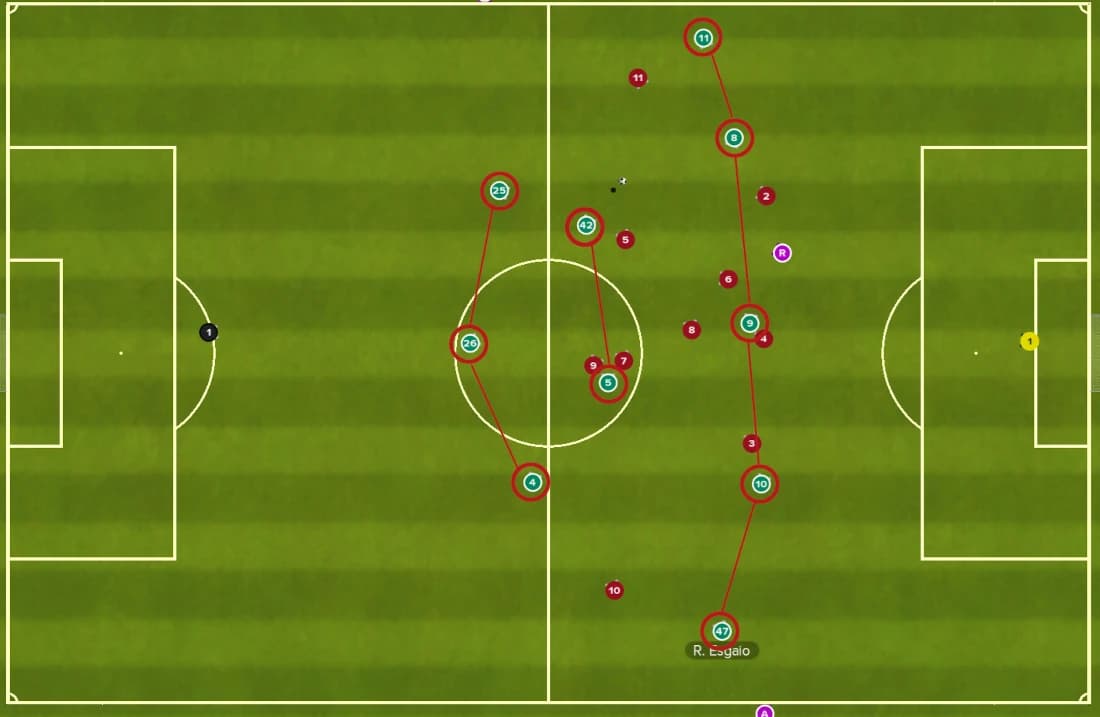
The 3-4-3 formation provides a compact shape which will be difficult to break down in the middle. The opposition has to attack down the wings, in the space between the wingbacks and the outer centre backs, or behind the defensive line as that’s where the majority of weaknesses are within this tactic.
Tactical Style
Ruben Amorim is a manager who favours a possession-based style of play using short to mid-short passes to move the opposition. We know he desires to press the opposition high and take risks both in defensive transition and in the attacking transition by counter-pressing wide and use counters as a strategy to create chances from these chaotic moments within the match where the opposition has to regroup and organize themselves.
In Football Manager, we got two opportunities to emulate Ruben Amorim’s tactical style; Vertical Tiki-Taka or Fluid Counter-Attack.
Personally, I would define Sporting CP’s style of play as a mix between the two, where they like to defend with a higher defensive line and trigger press more often. However, I wouldn’t say they are Working the ball into the box by patiently waiting for spaces to erupt. Instead, the front trio often likes to run at the defence and cause chaos by carrying the ball into dangerous positions.
This means, that we need to make some adjustments to the team instructions to appropriately emulate Ruben Amorim’s football philosophy on Football Manager.
I have used the Vertical Tiki-Taka tactical style as the foundation for my tactics.
Team Instructions
Match Mentality: Positive
In Possession
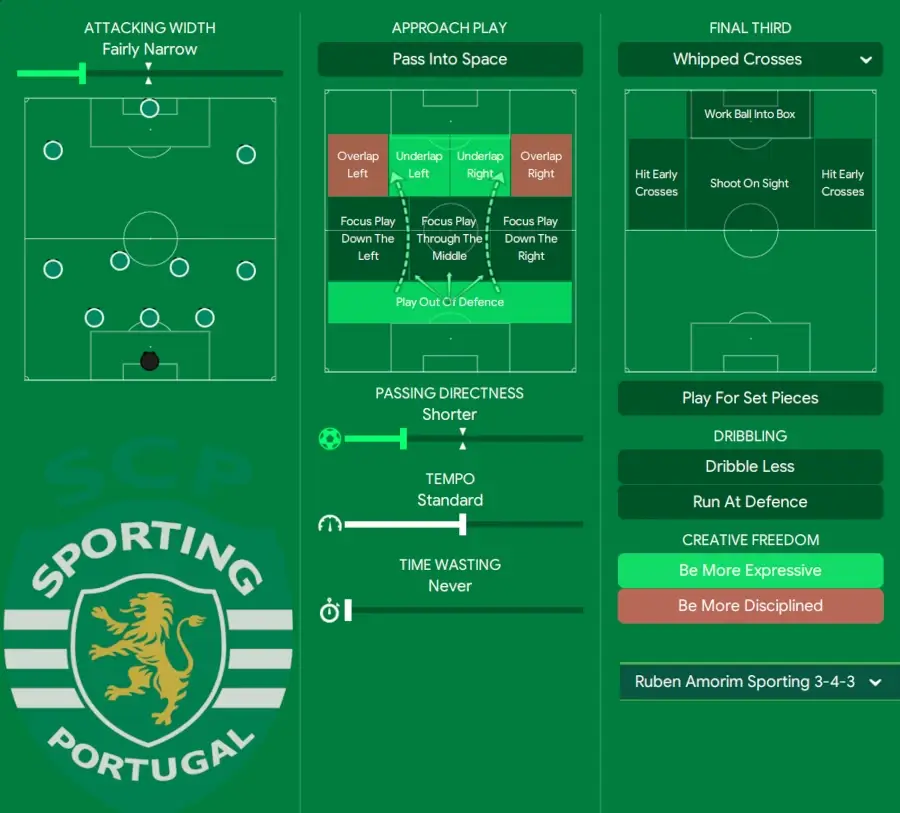
Tactical Options: Tick the Attacking Width to Fairly Wide to increase the space between the front five & force the opposition to defend wider.
You can also mimic Sporting by instructing the team to put more focus on playind down the Left Flank.
In Transition
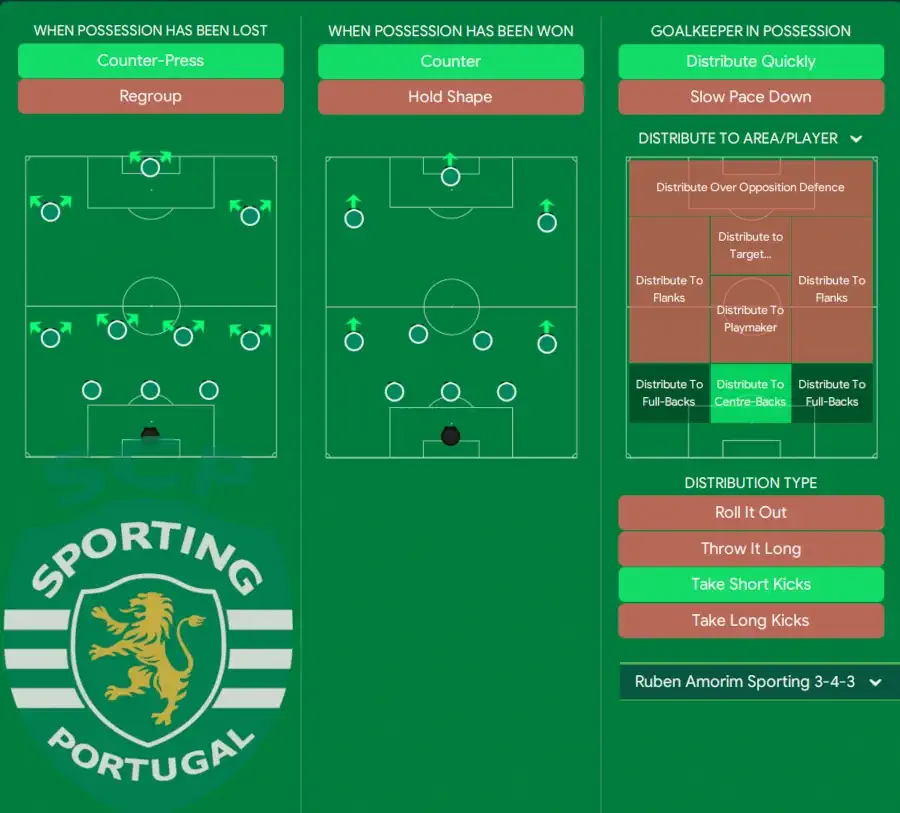
Out of Possession
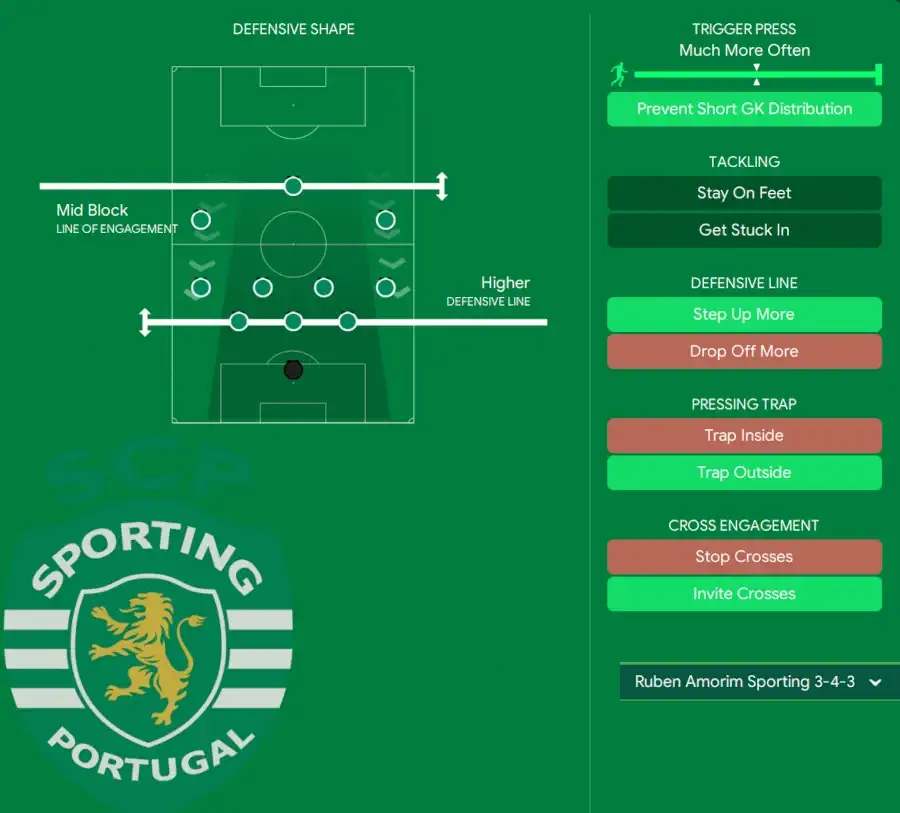
Tactical Options: Defensive Line: Standard against bigger teams, Reduce Pressing Intensity to ‘Close Down More’ to maintain a better pressing shape & avoid players are rushing out of their positioning.
Player Roles of Ruben Amorim’s 3-4-3 Tactic Football Manager 2024
Sporting’s 3-4-3 Formation
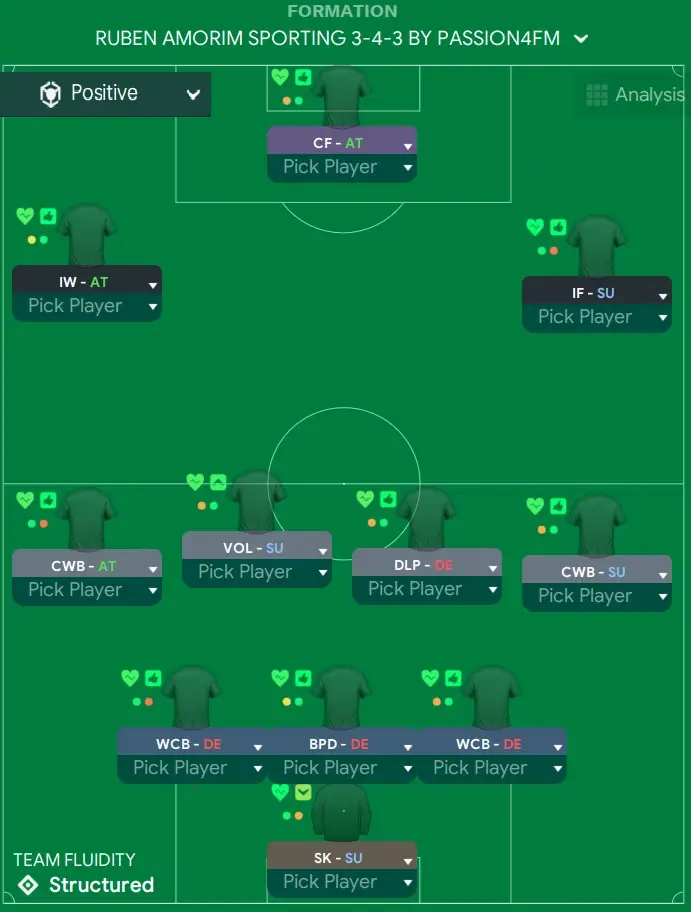
GK: Sweeper Keeper-Support:
To replicate how the Sporting goalkeeper operates on the ball, I’ve gone for a Sweeper Keeper on Support. As a player who can initiate counter-attacking passes when the opportunity arises, I feel SK-S is the best option, at least within this match engine. The goalkeeper must be comfortable with his feet and be able to rush out and sweep up loose balls that arrives behind the back line. At the same time, you want a player who can contribute in the build-up with his composure, anticipation, first touch and passing abilities.
Player Mentality: Positive
DCR: Ball-Playing Defender-Defend
On the outer right of the back three, I’ve gone for a Ball-Playing Defender to mimic the role of Eduardo Queresma. This player often initiates more direct passes in the build-up phase towards one of the players within the front-trio. To ensure the player defends the half space channels in possession I’ve ticked ‘Stay Wider’ to replicate how the WCB would behave in possession. At the same time, he will hold position alongside his centre-back partners and protect against those counter-attacking opportunities if the ball is lost high up the pitch.
NB! There’s nothing wrong about changing the role into a Wide-Centre Back on defend duty.
Player Instructions: Stay Wider + Mark Tighter
Player Mentality: Cautious
DCL: Wide-Centre Back-Defend
On the left side of the back three I’ve chosen a Wide-Centre back to replicate how Inacio protects and overloads the left half space channels as the left wingback aggressively moves forward in the attacking phase. This player will stay wider when the team is in possession and can use his angled position to either switch the play by connecting the left side with the players in the centre channel or make crosses from deep towards the front trio if the opposition holds a high defensive line.
Player Instructions: Mark Tighter
Player Mentality: Cautious
DC: Ball-Playing Defender-Defend
In the centre you’ll have a traditional ball-playing defender to form a back two, when or if the Wide Centre Back on the outer left moves slightly higher up the pitch. The player will need to dominate the middle channel with great positioning, concentration, anticipation and physic. At the same time, the player will need the quickness to protect the area behind the high defensive line and could drop off and defend the vulnerable zones between the wide back three.
Player Instructions: Close Down Less
Player Mentality: Cautious
WBR: Complete Wingback-Support
Since the player often looks to impact the final third, stays wide in the build-up and overall makes less crosses than the wingback, I’ve preferred the Complete Wingback role. On support, the player will combine his attacking instinct with defensive responsibilities. The player will become a natural outlet to progress play and will receive the ball a lot which will replicate the 60+ touches Esgaio had against Boavista where Sporting’s average position was a typical 3-2-5 formation with the wingbacks providing an attack threat on the wings, and the front five spread perfectly across the five channels.
Secondary Role: Wingback-Support (with Stay Wider)
Player Instructions: Mark Tighter
Player Mentality: Attacking
WBL: Complete Wingback-Attack
To mimic the role of Nuno Santos, I could have used a wingback on attack. However, due to his movement in the final third and how he is more of a winger than a fullback, I’ve gone for the Complete Wingback. On attack duty, he will help to overload the left side of the pitch. The players will look to him as he stretches the pitch and will make a lot of touches. With the ball, he can either combine with his closest Forward or aggressively cross the ball from the byline.
Player Instructions: Cross More Often + Mark Tighter
Player Mentality: Attacking
DMCL: Segundo Volante-Support
To replicate Sporting’s double pivot I could have chosen a Defensive Midfielder on defend coupled with a Defensive Midfielder on Support. Instead, I’ve gone for a pair that enables the team to switch into a 3-1-6 shape when attacking.
The Segundo Volante enables me to instruct the second pivot to move into channels and make those late runs towards and often inside the penalty box* (on attack duty). His off the ball movement in the left half space will contribute to a left side dominance as he will help to overload that area together with the wingback and the Inside Forward.
His decision-making on when to get forward, his off the ball movement, technical abilities and passing vision in the final third will help you to see some wonderful play with this role.
Personally, I just love how he picks up positions in the pockets and becomes a goalscoring threat from deep with his ability to overload the centre. He is truly a difficult player for the opposition to catch with his late deep runs into the penalty area.
Tactical Option: Change the Volante from to Support to Attack when you are chasing a goal. However, with Attack duty it’s easy the midfield will be overrun in defensive transition but then again, you’ll get a player entering the penalty box more often and overload that left half space to a greater degree.
Player Instructions: Get Further Forward, Dribble Less & Moves into Channels + Mark Tighter
Player Mentality: Positive
DMCR: Deep-Lying Playmaker-Defend
To give the second pivot the freedom to move higher up the pitch, we need a player who can hold position in front of the back three and protect the centre. Rather than a DM, I love how the Deep-Lying Playmaker behaves in possession tactics like this.
A player his teammates will look towards to in the build-up and one who can combine with the complete wingback to his side, the DLP-D provides that extra layer of security at the back whilst also being able to find his teammates with some wonderful progressive passes from the middle third and into the attacking third.
Player Instructions: Tackle Harder
Player Mentality: Cautious
AMR: Inside Forward-Support
On the right, the Inside Forward will look to move from his wide position and into the centre of the pitch. By finding pockets in the right half space channel he will create space for the wingback to make overlapping runs and stay more connected to the target forward. With support duty, he will move into channels and use his flair and unpredictability to cut inside with the ball, when the opportunity arises.
Player Instructions: Sit Narrower & Roam From Position + Mark Tighter
Player Mentality: Attacking
AML: Inverted Winger-Attack
On the left, I’ve focused on the diagonal runs and carries of Pedro Gonçalves. A player can be described as the team’s second forward or a creative winger, his attacking directness, dribbles and long shots provides an extra layer to the team’s attack. His direct running with the ball at his feet coupled with his given player instructions will help the IW-A to create chances for the forward or combine with him.
Secondary role: Inside Forward-Attack
Player Instructions: Roam From Position, Aim at Far Post + Mark Tighter
Player Mentality: Very Attacking
ST: Complete Forward-Attack
Up front, I’ve gone for a Complete Forward with attack duty. He will swap between dropping deep in the build-up, draw opposing defenders onto himself before playing in his forward partners with moving into channels and using forward runs to create space for the inside forwards to run into. As the main goalscorer within the team, you want a highly versatile player who has both the physic of a target man as well as the goalscoring instinct of Erling Haaland.
Player Instructions: Mark Tighter
Player Mentality: Very Attacking
Download Ruben Amorim’s Tactics for FM24
Incorporate Ruben Amorim’s 3-4-3 Sporting tactic on FM24 with our latest tactical recreation. Apply Ruben Amorim’s style of play used at Sporting CP for 2023-24 and discover the wonderful pass-and-move tactics of Ruben Amorim on Football Manager.
Released: 30.08.2024


